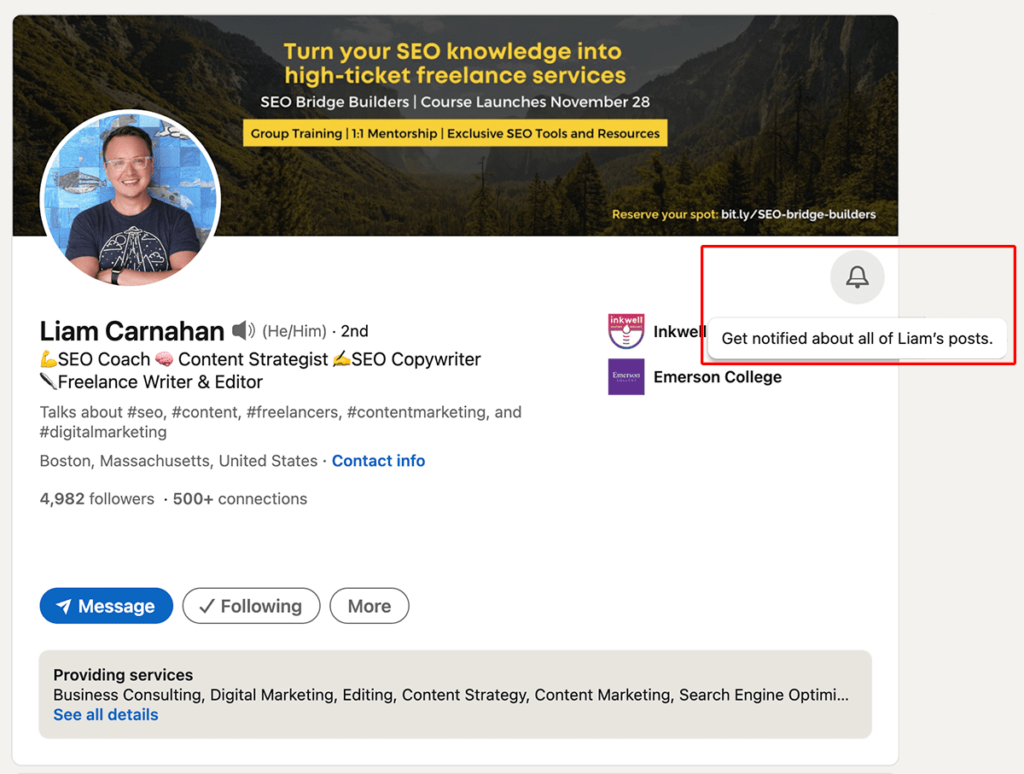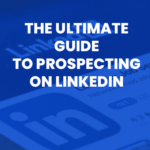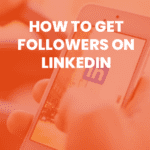Table of Contents
If you had told me a few years ago that I’d be writing a blog about how to use LinkedIn effectively, I’d have laughed.
For most of my career, I refused to use the platform unless I was actively looking for a job. I thought of it as Facebook’s stuffy big sibling, full of people bragging about their promotions and using annoying business jargon.
Everything changed in 2018 when I started working for myself. After learning from a few other folks and trying my own hand at it, I realized I’d seriously been missing out.
Now I use LinkedIn every single day. I’ve made friends through the platform, and it’s taken my career to new heights.
In this article, I’ll give you my very best LinkedIn tips to help you advance your career. Tips that will help you leverage your LinkedIn network into big gains in your line of work.
This article won’t cover any of the basic stuff, like setting up a profile or sending cold DMs. We cover a lot of that in these articles:
If you’ve already set up a profile and are ready to go to the next level with your LinkedIn networking, read on.
Tip #1. Give away helpful advice (and ask for nothing in exchange)
Like any social media platform, creating posts is a big part of the LinkedIn game. And you’ll see plenty of differing opinions about what’s best to post: success stories, questions, testimonials, and so on.
It’s always good to craft a few different styles of posts, but there should be one type of post you make more often than others: free, helpful advice. And for the most part, don’t ask for anything in return.
Your goal with these posts should be to establish yourself as an expert on a subject (whatever it is you want to do for your career). You want your audience to see your name in their feed and know they’ll get some good free advice without being sold to.
If you try to sell too much (by promoting your services or stating what you’re looking for), people will start to scroll past your name without giving you a second thought.
But when you give free advice, they’ll do something else: They’ll interact. You’ll get more comments on your posts. You’ll get more DMs of people asking you questions about your area of expertise. Once you start building these kinds of relationships, it becomes much easier to be promotional without appearing desperate.
Here’s an example post from my feed. I work in SEO, so I make lots of posts like this to attract people who want to learn more about the industry:
Tip #2. Don’t put links in your post (put them in the comments instead)
You may want to use your LinkedIn posts to point people to another website: your blog, portfolio, or a resource, for example.
Unfortunately, putting a link to a website outside of LinkedIn is likely going to throttle your engagement. LinkedIn hasn’t explicitly said this, but it makes sense—the algorithm wants people to stay on LinkedIn, not leave to visit other sites. There’s a lot of speculation that LinkedIn then reduces the number of views of your content to prevent people from clicking out of the site.
There’s an easy way around this: Put the link in the first comment. You can let people in the post know there’s a link below (though I recommend using 🔗 instead of the word “link,” as I suspect the algorithm might not like that word at all).
LinkedIn now allows you to pin comments on a post after you’ve gotten one or two additional comments beyond your own. Be sure to pin your comment with the link so it’s easy to find, like I’ve done in this example:

Tip #3. Interact with other posts before and after you write your own, and respond to comments ASAP
Posting is important but equally important is how you engage with LinkedIn before and after your post. Once again, LinkedIn hasn’t confirmed this, but many people agree: Interacting with the platform before and after you post improves your chances of engagement.
Before you write a post, spend 20 – 30 minutes scrolling through your feed liking and posting thoughtful comments on others’ posts. Do this again after you’ve made your post public.
The more comments you make, the more likely your post will show up in the feeds of other people who saw your comments. Engagement will almost certainly go up.
On a similar note, be sure you have email or phone alerts set up for when you get comments on your post. Respond to any comments you get as soon as you can—this lets the algorithm know you’re engaged and will keep your post in the feed longer.
That being said, if you have a viral moment and get lots of comments, you can respond to the comments that come in a day or two after you post. This will revive the post and give it another round on people’s feeds.
Tip #4. Fill your network with people working in “adjacent careers”
As you learn how to use LinkedIn and begin posting and interacting more, you’ll naturally start to grow an audience. You can also build up your audience faster by sending out a few connection requests every time you log in.
When doing this, don’t look for people in the exact same industry as you (though there’s nothing wrong with having connections with these people). Instead, look for two groups of people:
1. People who are in your target audience
2. People who are in “adjacent” career paths to your own
My target audience is people who need SEO services and freelancers who want to learn SEO (as I run training programs for them).
People in “adjacent careers” are web designers, developers, and graphic designers. These people don’t offer the exact same services as me, but they work with similar clients who need digital marketing help.
This makes them prime candidates to pass referrals and connections my way when they meet someone who needs one of my services. (I, of course, do the same in return for people I know.) Competitors who are in your exact same industry are far less likely to pass on referrals like this.
Tip #5. Upload PDF files for an instant slideshow
When you upload posts to LinkedIn, you can improve your engagement by adding some media: an eye-catching image or a short video, for example.
If you add multiple pictures to a LinkedIn post, the platform shows them as though they are in a gallery (much like on Facebook). This isn’t the greatest user experience if you want people to look at images in a specific order, like a slideshow.
How do you get around this? Save your images as a PDF rather than individual images, and upload that as a file in lieu of pictures. This automatically converts it into a slideshow, which is an excellent way to show multiple visuals in a specific order.
Here’s an example. I made these slides in about 10 minutes using Canva (which even has settings for sizing images for LinkedIn):
Tip #6. Join groups and double-up your posting power
There are groups on LinkedIn for virtually every career path and area of expertise you can imagine. It’s worthwhile joining these groups and interacting with posts there. (This is an excellent method to grow your network.)
When you join enough groups, LinkedIn will give you the option to double-post content on your own feed and in a relevant group.
When you see this option pop up, take it. You can get significantly more engagement on any given post with just the click of a button. If you do this enough, you may be able to build a name for yourself in some of the more active groups.
Tip #7. If the algorithm suggests you do something, DO IT!
If you pay attention while scrolling through LinkedIn, you’ll see the algorithm is hard at work, encouraging you to take certain actions.
For example, the platform may show you posts from someone you don’t currently follow, suggesting you follow them. It may encourage you to turn one of your lengthier comments into a post of its own or to repost someone else’s post.
When you see the subtle nudges from LinkedIn, take them up on the opportunity. Not only do these usually help you engage with the platform in a more meaningful way, but these actions also send positive signals back to the algorithm, letting it know you’re using the platform to its full potential.

Tip #8. Set up alerts for top profiles and comment quickly
Here’s one of the fastest ways to grow your footprint on LinkedIn.
As you’re growing your network, keep an eye out for people who:
1. Post regularly and get LOTS of engagement (50+ comments and 100+ likes)
2. Post about similar topics to what you discuss
When you visit this person’s profile, you can set up an alert so that you’ll be notified (either in your notifications section on LinkedIn or on your devices) every time they post.

As soon as you see one of those alerts, head over to the post, read it, and leave a thoughtful comment. The sooner you can do this after they post, the better.
As their post inevitably starts to gain traction, your comment will be near the top and get lots of engagement as well. This can help you grow your following much faster, as anyone who likes your comment will soon start seeing your posts in their feed.
Tip #9. Repurpose your best posts into something more
Posting on LinkedIn can be time-consuming. That’s why I highly recommend getting the most leverage out of your most popular posts by turning them into something more.
Think of LinkedIn as a testing ground. Every time you make a post, you’re gauging what your audience wants to hear about and refining your style. When a post of yours performs well, that’s an indication that your audience would like more on that topic.
There are a few ways you can repurpose content from LinkedIn:
- Expand it and turn it into a blog on your website
- Turn it into a Twitter thread
- Use the content for an email for your mailing list
- Create a graphic version of the article to post on Instagram/Twitter
- Turn the content into a video blog
Since you already have the content, it’s a no-brainer to spend a little more time repurposing it into something that will reach your audience in a different way on different platforms.
Final thoughts: test, experiment, and break the rules every once in a while
I’ve changed my opinion on LinkedIn. It’s not a stuffy virtual office—it’s a place where experts connect and share knowledge with each other.
The key to LinkedIn (and indeed any social media platform) is to develop your own voice and style. This means you’ll need to experiment. Try different formats for posting. Write a post that’s only one sentence long. Try video and imagery and slideshows. Share personal stories. Tag people who inspire you.
Let out your creativity and see what sticks. In no time, you’ll find LinkedIn is the absolute best place for networking and growing your career.
See you on the platform!






